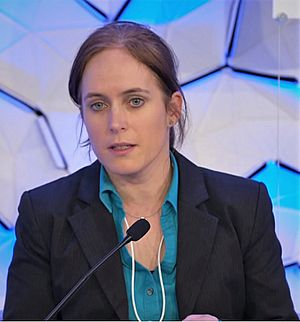Gabriela Hug facts for kids
Quick facts for kids
Gabriela Hug
|
|
|---|---|

Hug speaks at the 2018 World Economic Forum
|
|
| Born | 1979 (age 45–46) Baden, Switzerland
|
| Alma mater | ETH Zürich |
| Known for | Control and optimization of electrical power systems |
| Awards | 2013 IEEE Power and Energy Society Outstanding Young Engineer Award, 2013 George Tallman Ladd Award, 2013 US National Science Foundation Career Award |
| Scientific career | |
| Fields | Electrical Engineering, Electrical Power System |
| Institutions | Swiss Federal Institute of Technology ETH Zürich, Carnegie Mellon University |
Gabriela Hug-Glanzmann (born 1979) is a Swiss electrical engineer. She is a professor and leads the Power Systems Laboratory at the Swiss Federal Institute of Technology (ETH) Zürich. Professor Hug studies how to control and improve electrical power systems. Her main goal is to make sure we use clean, sustainable energy in the best way possible.
Contents
Early Life and Education
Gabriela Hug started her studies in Electrical and Computer Engineering at ETH Zurich in 1999. She earned her Master's degree in 2004 and then her Ph.D. in 2008.
For her Master's, she researched special devices called FACTS. These devices help control and make the best use of electricity in power lines. Her Master's project looked at a new way to control water levels in river power plants. This helped reduce wasted energy and protect the environment.
During her Ph.D., Gabriela Hug studied how to set up these FACTS devices. She found a way to quickly check the state of an energy system. This was helpful for understanding what happens during a power outage. She also completed a teaching diploma in 2007.
Career and Research
After finishing her studies, Gabriela Hug moved to Canada in 2008. She worked for a year at Hydro One, a big electricity company.
In 2009, she became a professor at Carnegie Mellon University in the United States. There, she helped lead a group focused on electric energy systems. She also worked on managing how electricity is sent and shared.
At Carnegie Mellon, Professor Hug explored how to run electrical energy systems in the best way. She looked at how to share power generation and store energy. This helps us use more renewable energy sources like solar and wind power. It also makes energy systems more efficient and flexible. She developed smart ways to control energy storage devices, like big batteries.
Since 2015, she has been a professor back at ETH Zurich in Switzerland. She still works with Carnegie Mellon University as well.
Smart Control for Energy Systems
Professor Hug believes we need to switch to renewable energy sources. This is important to keep our planet healthy. She works on solving the challenges of renewable energy, like when the sun isn't shining or the wind isn't blowing. Her goal is to make sure we can always get reliable power from sustainable sources.
To do this, her team uses computer models to simulate the power grid. They figure out the best ways to combine and share different energy sources. Since a modern grid has many different parts, it can be hard to coordinate them all. Professor Hug has suggested using smart systems to balance how much energy is available and how much is needed.
She also shows that smart, cooperative strategies can help manage energy storage systems. These systems need to charge and release energy at the right times to work well. Her simulations showed that these strategies can reduce energy loss. They also ensure that energy supply always meets demand.
Because modern energy grids use a lot of data, they can be targets for cyber-attacks. Besides her work on energy optimization, Professor Hug also researches how to prevent these attacks. She uses computer programs to find the most likely places an attacker might strike. This helps guide where the most security is needed in the grid.
Awards and Honors
Gabriela Hug has received many awards for her important work:
- 2019 ALEA Award - Art of Leadership Award ETH Zürich
- 2015 Eta Kappa Nu Excellence in Teaching Award
- 2014 Raymond John Wean Foundation Career Development Professorship at Carnegie Mellon University
- 2013 George Tallman Ladd Award
- 2013 IEEE Power and Energy Society Outstanding Young Engineer Award
- 2013 US National Science Foundation Career Award
- 2008 ABB Research Award in honor of Hubertus von Gruenberg for her Ph.D. Thesis
- 2005 EtherCAT Technology Group Innovation Award For her Master's Thesis
- 2004 ETH Zürich Medal

